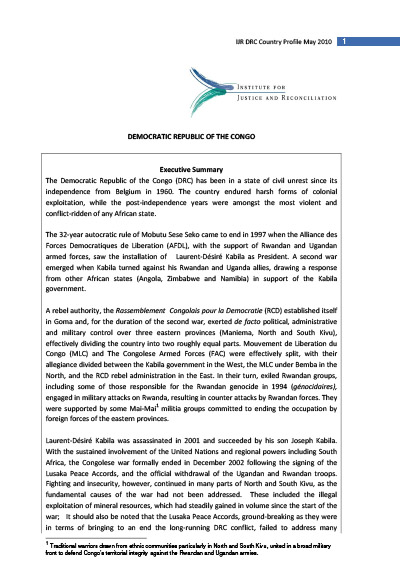
IJR DRC Country Profile
The Democratic Republic of the Congo (DRC) has been in a state of civil unrest since its independence from Belgium in 1960. The country endured harsh forms of colonial exploitation, while the post-independence years were amongst the most violent and conflict-ridden of any African state.
The 32-year autocratic rule of Mobutu Sese Seko came to end in 1997 when the Alliance des Forces Democratiques de Liberation (AFDL), with the support of Rwandan and Ugandan armed forces, saw the installation of Laurent-Désiré Kabila as President. A second war emerged when Kabila turned against his Rwandan and Uganda allies, drawing a response from other African states (Angola, Zimbabwe and Namibia) in support of the Kabila government.
A rebel authority, the Rassemblement Congolais pour la Democratie (RCD) established itself in Goma and, for the duration of the second war, exerted de facto political, administrative and military control over three eastern provinces (Maniema, North and South Kivu), effectively dividing the country into two roughly equal parts. Mouvement de Liberation du Congo (MLC) and The Congolese Armed Forces (FAC) were effectively split, with their allegiance divided between the Kabila government in the West, the MLC under Bemba in the North, and the RCD rebel administration in the East. In their turn, exiled Rwandan groups, including some of those responsible for the Rwandan genocide in 1994 (génocidaires), engaged in military attacks on Rwanda, resulting in counter attacks by Rwandan forces. They were supported by some Mai-Mai1 militia groups committed to ending the occupation by foreign forces of the eastern provinces.
Laurent-Désiré Kabila was assassinated in 2001 and succeeded by his son Joseph Kabila. With the sustained involvement of the United Nations and regional powers including South Africa, the Congolese war formally ended in December 2002 following the signing of the Lusaka Peace Accords, and the official withdrawal of the Ugandan and Rwandan troops. Fighting and insecurity, however, continued in many parts of North and South Kivu, as the fundamental causes of the war had not been addressed. These included the illegal exploitation of mineral resources, which had steadily gained in volume since the start of the war; It should also be noted that the Lusaka Peace Accords, ground-breaking as they were in terms of bringing to an end the long-running DRC conflict, failed to address many underlying issues and indeed, sowed the seeds for new discord in the future. Most notably, the Accords contained a clause stipulating the establishment of a Truth and Reconciliation Commission which was to deal with remaining obstacles to peace in that country.
The involvement of UN peacekeepers, democratic elections in 2006, and joint military operations undertaken by the Congolese and Rwandan armies in 2009 to disband the FDLR with the Congrès National pour la Défense du Peuple (CNDP) rebel faction in the Kivu provinces, aimed at creating new opportunities for peace and stability in the DRC and the Great Lakes region. There are at the same time many obstacles to sustainable peace. These include material inequity, the looting and exploitation of minerals, a chronic humanitarian crisis and Forces Démocratiques pour la Libération du Rwanda (FDLR) combatants remaining on Congolese soil. In a country where the roots of conflict remain largely unaddressed, ethnic manipulation for particularist interests remains a threat.
Pages: 14
Dimensions: A4
Date of publication: 2010




